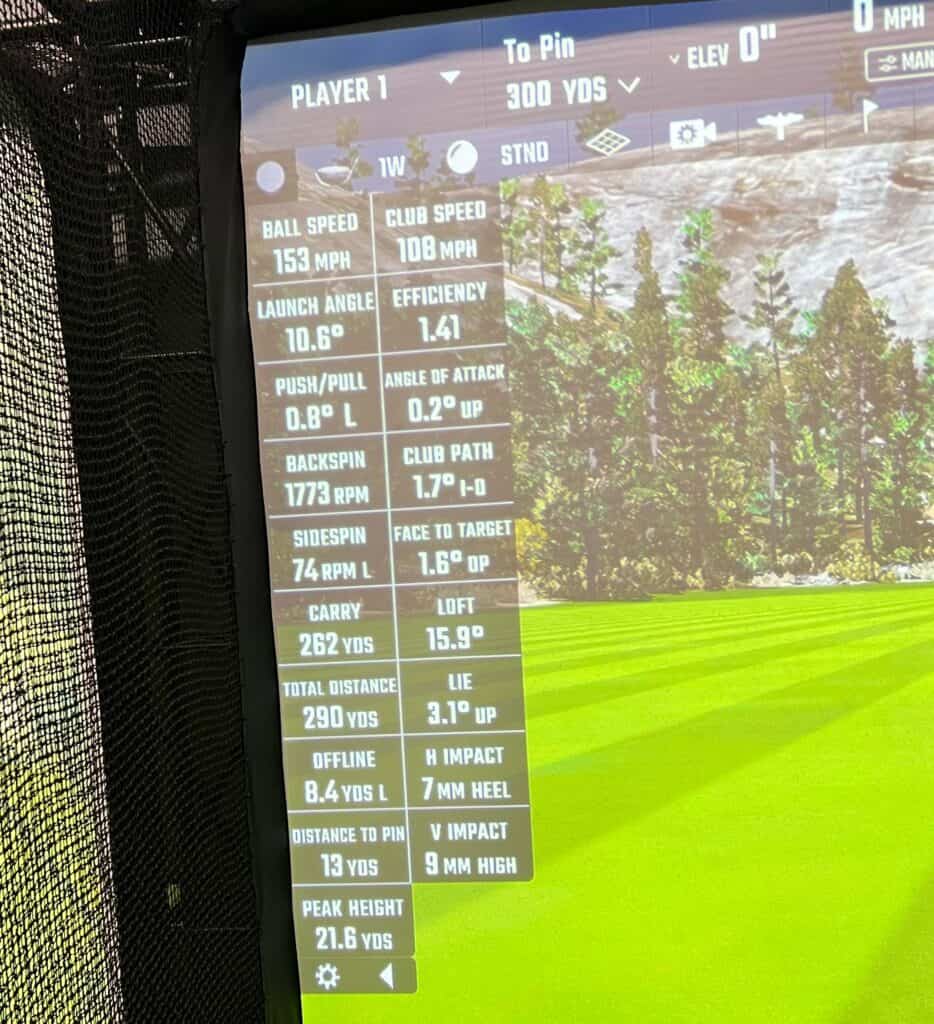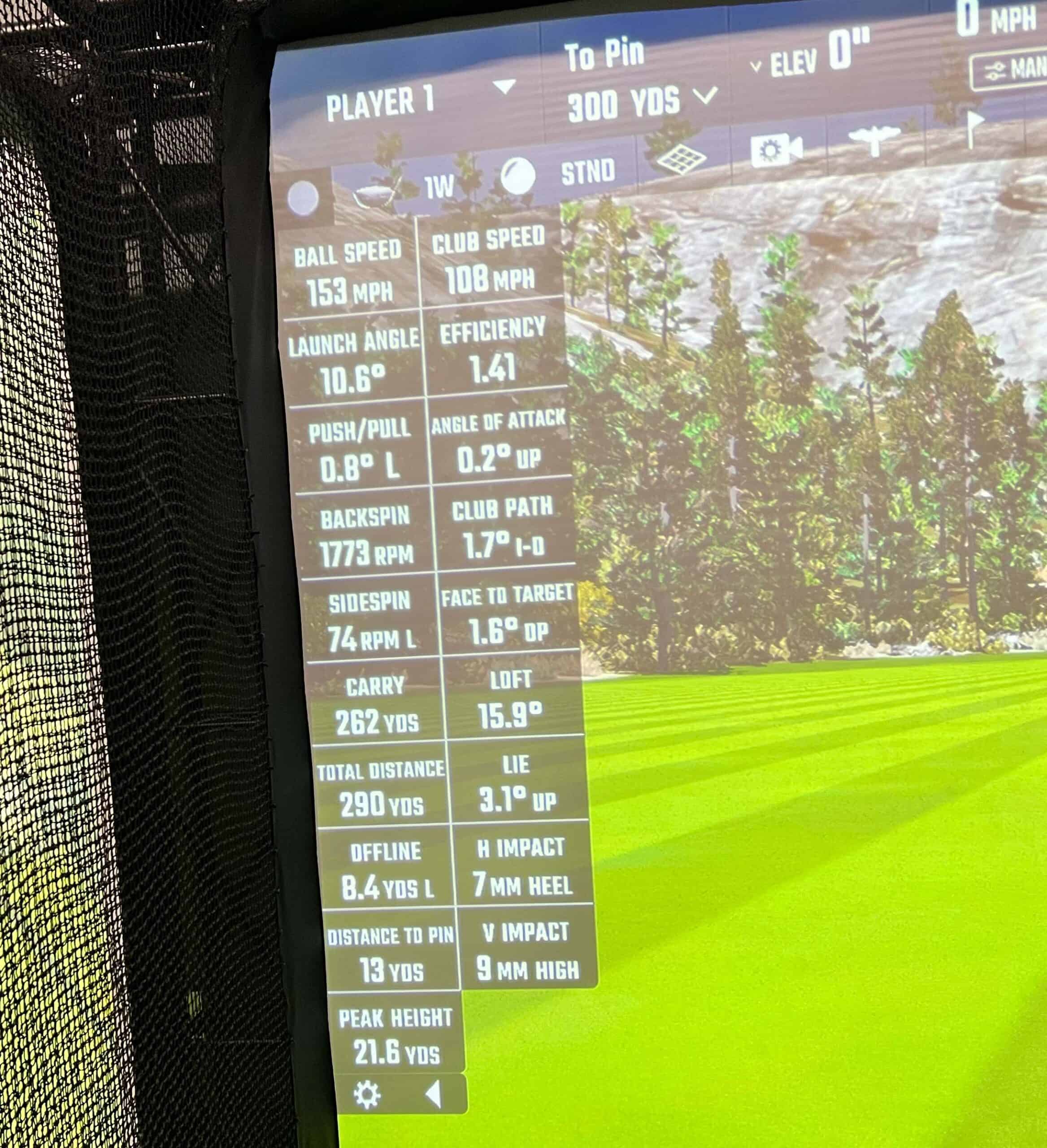It’s fun to hit balls indoors or out and see all of your data immediately after you hit the shot. But what does it all mean? What should your ball speed be? Is 1.2 degrees in to out a good club path? Without an expert standing next to you, it’s hard to know.
So let this post be your guiding light. Understand exactly what all of your data means and how it stacks up. That way, you can start improving your game in a smart and meaningful way.
Ball Speed
This is how fast your ball moves when it leaves the club. Most PGA tour pros have 165 mph ball speed or above. But for amateurs, anything over 150 is fantastic. The ball speed will get progressively slower as you hit shorter clubs.
Launch Angle
This isn’t one we pay a ton of attention to. The higher the loft, the higher your launch angle will be. A good launch angle is a result of a good swing.
Push/Pull
While self-explanatory, your push/pull number is essential. If you typically hit a draw, you want a bit of a push to start. If you hit a fade, a slight pull number is ideal. This is mainly related to your club’s face-to-target and path. We’ll get to those later.
Backspin
The lower your backspin number, the better when it comes to hitting driver. Anything below 2,500 RPM is excellent. The backspin number will go up when you hit clubs with more loft. The closer you hit your driver to the center of the face, the lower the backspin number will be.
Sidespin
High side spin on any club is bad news. It can lead to big hooks or slices. But it also results from impact location and your club’s face to target and path.
Carry
Carry is the main number good players and tour pros pay attention to. While you can hit your 7 iron 180 with rollout, it only carries 165. So, if you have to carry water or a trap 170 yards away, you’ll fool yourself into thinking you can make it happen.
One of the most important pieces of advice we give at Tee It Up Canton is to watch your carry number more than your total number. You never know how much roll you’ll get on any given day, and you need to know whether you can carry a hazard.
Total Distance
Total distance is carry plus roll. Most golfers only know their total distance numbers. But as we described above, carry distance may be more critical. If you hit a drive downhill on a dry day, your total distance will be much longer than on an uphill hole on a wet day. You’re doing pretty well if you can get your driver’s total distance to 250 yards or better.
Offline
This number is simply how far off you were from where you were aimed. Anything within 10 yards left or right will be perfectly fine on the course.
Distance to Pin
Distance to pin is self-explanatory. It’s how far your ball is from the hole. This is more important on approach shots than drives.
Peak Height
Your peak height matters, especially when you play in windy conditions. The lower you keep the ball, the less the wind can affect it. But, a higher ball flight will land softly on the green and stick instead of rolling off.
Club Speed
Club speed is something you’ll hear a lot of golfers talk about especially when it comes to drivers. Big hitters’ club speed is usually over 112 mph. But average players are usually between 95-105 mph. These numbers are just fine if you hit it straight. The stronger you get, the more club head speed you’ll have.
Efficiency/Smash Factor
Another hugely important number – efficiency is ball speed divided by club speed. Anything over 1.4 is excellent for drivers. And anything over 1.3 is ideal for iron shots.
Angle of Attack
Good angle of attack numbers vary depending on your club. Wedges and irons require a downward angle somewhere between two and eight degrees. While drivers will work best with an upward angle of attack.
Club Path
The four data points we pay the most attention to are club path, face to target, horizontal impact and vertical impact. For club path, the closer to 0 degrees, the better. But you can play between four degrees out to in or in to out. You’ll probably hit a big hook if you have a large in-to-out number. The opposite is true for a big out-to-in club path.
Face to Target
The combination of club path and face to target are the two biggest determining factors for where your shot goes. If you have an in-to-out club path – you want an open club face. For example, a four-degree club path and a two-degree open club face create a perfect baby draw. On the other hand, a four-degree out-to-in club path with a two-degree closed club face will result in a baby fade.
The more open your club face is, the more your ball will slice. The more closed it is, the more it will hook. Ensuring your club face is square at impact is imperative to a great golf game.
Loft
Loft is the degree of the club at impact. Most drivers are between eight and 12 degrees. But loft is typically a bit higher on drivers and a bit lower on irons because players try to swing down at the ball.
Lie
Lie is better described as toe up/toe down. Many amateurs have large toe down numbers, but the closer you get that number to 0 or toe up, the better. This is heavily considered during iron fittings because iron heads can be adjusted for your lie angle.
Horizontal Impact
Is your typical miss off the toe? Off the heel? That’s what horizontal impact is. Hitting the ball as close to the center of the face as possible will give you more distance, accuracy and consistency. Toe misses tend to result in hooks, while heel misses result in slices.
Vertical Impact
Same thing as horizontal impact – the closer to the center, the better. If you have a high vertical impact, you probably chunked it. If it’s a few millimeters low, you hit a thin shot. Thin shots are much more playable than chunks.
Conclusion
There’s obviously a lot that goes into a golf swing. But understanding your data while not getting overwhelmed by it will help you quickly improve your game. Want to see the numbers for yourself? Book a bay at Tee It Up Canton today!



